


VI. Analysis of Data Products
3. Photometric Accuracy
b. Photometric Accuracy
The WISE photometric accuracy requirement concerns bright, S/N > 100, stars that not
confused by nearby sources, or any way resolved, and are free of saturation.
The stated requirement is as follows:
The root mean square error in relative photometric accuracy in the WISE Source Catalog shall be better than 7% in each band for unsaturated point sources with SNR>100, where the noise flux [includes] errors due to zodiacal foreground emission, instrumental effects, source photon statistics, and neighboring sources.
This requirement shall not apply to sources that [are] superimposed on an identified artifact.
We will be assessing the photometric accuracy of the WPRO (profile-fitting) photometry
of bright stars using the internal repeatability of WPRO measurements.
However, in order to draw the sample to study, we will be using the S/N
as given by the standard aperture photometry. The reason is that the WPRO S/N includes a contribution
due to the uncertainty in the Point Spread Function (PSF), essentially flooring all
S/N values to be less than S/N=60 or so; whereas, the aperture photometry provides a reasonable
estimate of source's S/N in a given band.
i. Highlighted Sample
For detailed study (Figures 1-4, presented below), we will first draw a clean sample of bright stars
from high galactic latitudes, avoiding the inner Galactic Bulge. We then draw samples from
other large regions of the sky stepping closer to the Plane of the Galaxy, and finally,
to test the
photometric accuracy in specific regions of the sky, including more complex ones,
we will also draw an additional seven samples. The results are presented below.
- Aperture photometry magnitude uncertainties: w?sigm < 0.01086 mag (S/N > 100)
- Avoid saturation, artifacts, blending, etc
- Avoid upper limits
- Apply w?rchi2 threshold to avoid extended sources and poor WPRO photometry
- WISE Pass 2 4-Band Multiframe Source Table
For example, the SQL command for W1 (band-1) extractions is as follows:
WHERE (glon > 90 and glon < 270 and glat > 65 and glat < 85
and (wx >= 36.4 and wx <= 4058.6 and wy >= 36.4 and wy <= 4058.6)
and use_src = 1 and nb = 1 and w1frtr = 0
and w1rchi2 <= 2 and w1sat = 0 and cc_flags[1]
not matches '[DHOP]' and w1sigmpro is not null and w1sigm < 0.01086) '
The database draw for W1 is about 700,000 sources. Examples of what some of these sources look like are
shown in Figure 1.
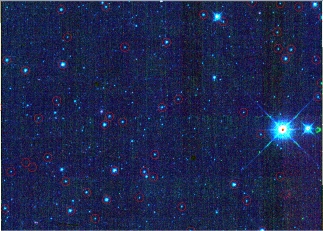 |
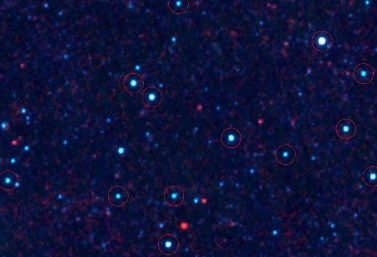 |
| Figure 1a - Unsaturated and unconfused bright, S/N > 100, sources in the field RA,DEC = 213.980, +10.070 deg, as viewed by the W1 (blue), W2 (green) and W3 (red) bands.
|
Figure 1b - Zoomed-in view of bright sources in field RA,DEC = 213.980, +10.070 deg.
|
The extracted photometry for the unsaturated, bright S/N > 100 sources is presented in next (Figure 2).
ii. Internal Repeatability
The WISE photometric accuracy is assessed using the
internal repeatability of WPRO measurements.
For a given source found on M individual frames (typically ~12), WPRO estimates the flux for each one and
the distribution statistics are part of the extracted information (per band) for the source.
The reported statistics include weighted mean, the unbiased weighted sample variance
(re: population variance) and the standard error of the mean.
Internal repeatability is a proxy for photometric accuracy, although it is not sensitive
to confusion noise. For our purposes here, confusion is not an important contributor to the flux uncertainty.
The W1 repeatability results for the bright S/N > 100 sample are shown
in Figure2. The panels show, per band, the standard deviation in the population (parameter
w?sigP1),
representing the RMS of WPRO measurements for one frame.
The results show that the photometric accuracy for each band, as indicated by the
repeatability RMS (w?sigP1), is ~2 to 3%, which is well within the requirement of 7% for bright S/N > 100 sources.
Figure 2: High Galactic Latitude Sky: GLAT > 65 deg (with 90 < GLON < 270 deg)
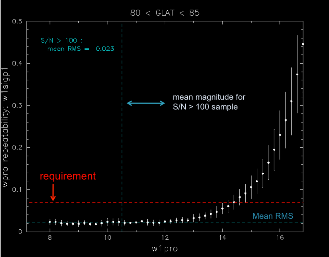 |
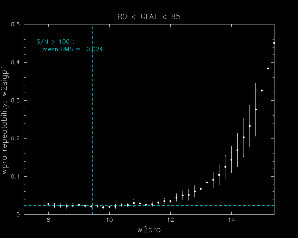 |
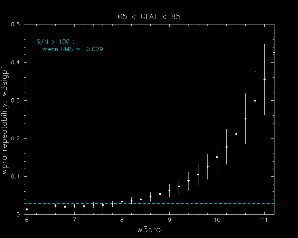 |
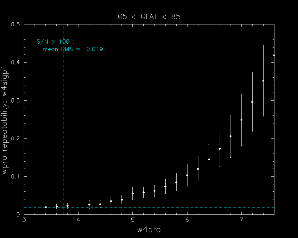 |
| Figure 2a - WPRO internal repeatability RMS of W1.
The red dashed line demarks the Photometric Accuracy requirement, and the blue dashed horizontal line the
achieve accuracy.
|
Figure 2b – WPRO internal repeatability RMS of W2. |
Figure 2c – WPRO internal repeatability RMS of W3. |
Figure 2d – WPRO internal repeatability RMS of W4. |
Figure 3: Moderate Galactic Latitude Sky: 40 < Glat < 50 deg
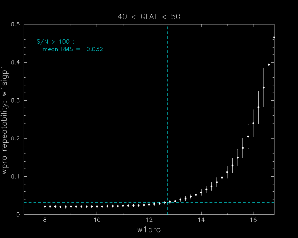 |
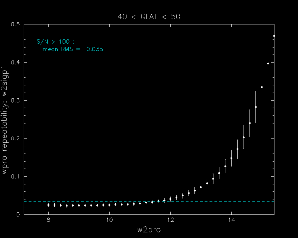 |
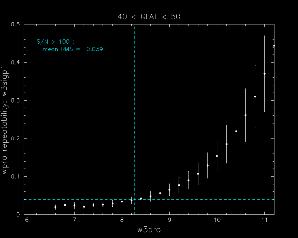 |
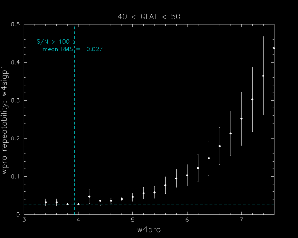 |
| Figure 3a - WPRO internal repeatability RMS of W1.
|
Figure 3b – WPRO internal repeatability RMS of W2. |
Figure 3c – WPRO internal repeatability RMS of W3. |
Figure 3d – WPRO internal repeatability RMS of W4. |
Figure 4: Moderate Galactic Latitude Sky: 20 < Glat < 30 deg
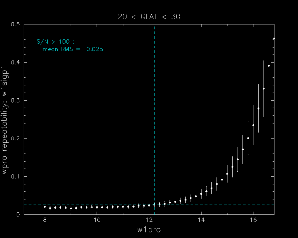 |
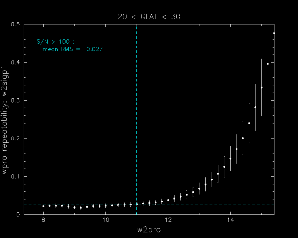 |
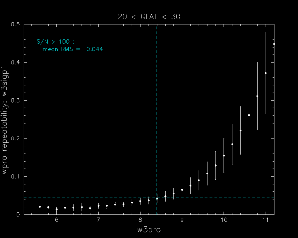 |
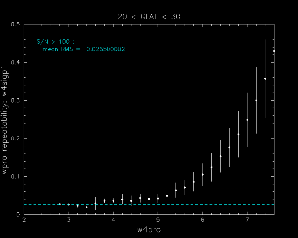 |
| Figure 4a - WPRO internal repeatability RMS of W1.
|
Figure 4b – WPRO internal repeatability RMS of W2. |
Figure 4c – WPRO internal repeatability RMS of W3. |
Figure 4d – WPRO internal repeatability RMS of W4. |
Figure 5: Low Galactic Latitude Sky: 7.5 < Glat < 12.5 deg
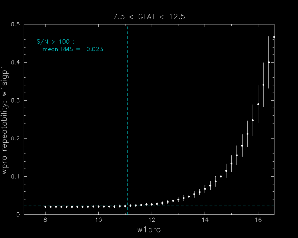 |
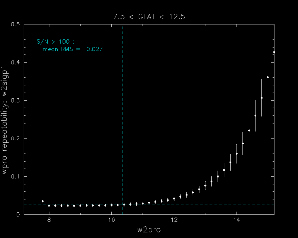 |
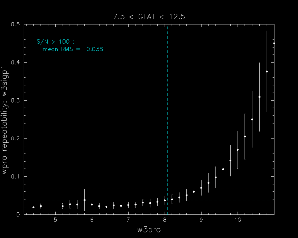 |
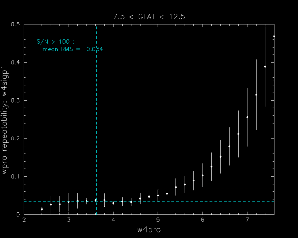 |
| Figure 5a - WPRO internal repeatability RMS of W1.
|
Figure 5b – WPRO internal repeatability RMS of W2. |
Figure 5c – WPRO internal repeatability RMS of W3. |
Figure 5d – WPRO internal repeatability RMS of W4. |
Figure 6: Galactic Plane: 0 < Glat < 2 deg
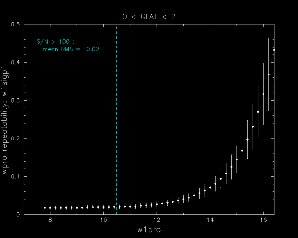 |
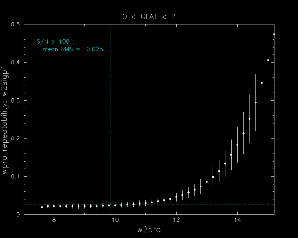 |
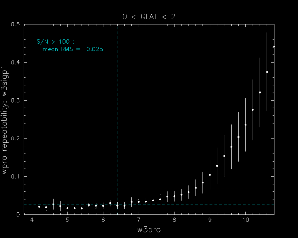 |
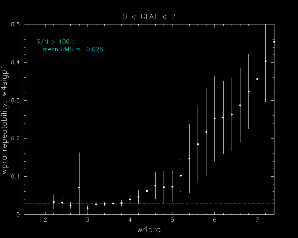 |
| Figure 6a - WPRO internal repeatability RMS of W1.
|
Figure 6b – WPRO internal repeatability RMS of W2. |
Figure 6c – WPRO internal repeatability RMS of W3. |
Figure 6d – WPRO internal repeatability RMS of W4. |
Table 1 – Summary of Photometric Repeatability for Large Regions of the Sky
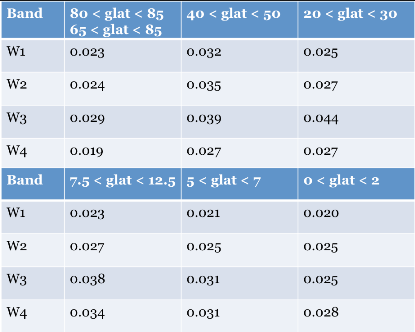 |
The following tables show the W1, W2, W3 and W4 repeatability results for seven smaller regions of the sky, including
high S/N>100 draws from the South Equatorial Pole, Ecliptic Plane, SDSS, CDF-S, open cluster
M67 and the Galactic Plane. Consistently in every case, the standard deviation in the repeatability population
distribution (w?sigP1) ranges between 2 and 3%, surpassing the requirement.
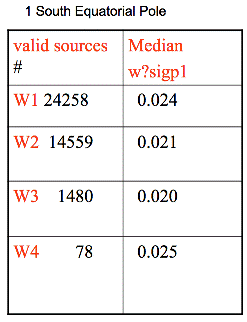 |
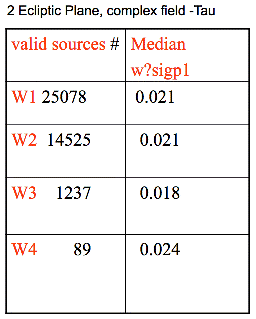 |
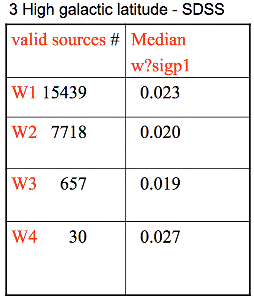 |
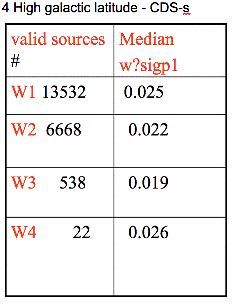 |
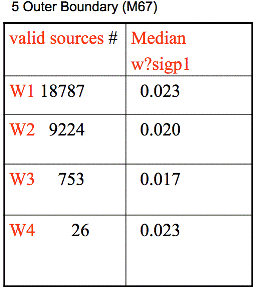 |
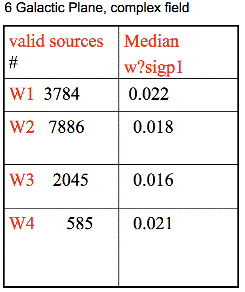 |
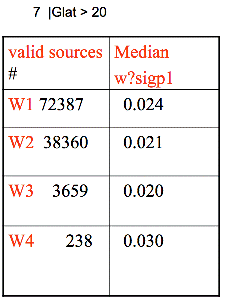 |
Figure 7a – South Equatorial Pole,
internal repeatability RMS (w?sigP1). |
Figure 7b – Taurus Molecular Cloud. |
Figure 7c – SDSS. |
Figure 7d – CDF-S |
Figure 7e – Cluster M67 |
Figure 7f – Galactic Plane |
Figure 7g – |glat| > 20 deg |
iii. Summary
WISE photometric accuracy, estimated using the internal repeatability of WPRO multi-frame measurements,
surpasses the survey requirement by more than a factor of 3, in all 4 bands, in the diverse set of fields presented
in this document.
Last update: 2012 March 16









